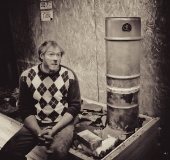This fall we built our first RMH. It is a 6 inch system with a seven foot bench. By the end of the build everything was working beautifully, but did not have a chance to let the stove really stretch its legs. Just got back from our first three days in the cabin and all aspects of the stove performed quite well save one. The bench never really heated up. both the cob between the barrel and the exterior wall and the cob around the feed chamber did, but never the bench. We ran the stove for several hours (4+) each day and finally this mornings firing started to lead to some heat in the bench. Do any of you have any thoughts of why this might be? Some thoughts I had are below.
1) The clay was not fully dry before the cabin froze for the winter so the stored water was actually ice?
2) The distance between the heat riser (6inch/8inch packed with clay and vermiculite mix) and the barrel is too big leading to most of the heat being transferred in the barrel?
3) The solid cob mass (17inches tall, 25 inches wide, and 7 feet long) is just a lot of cold cob for the system to heat up from 10-15 degrees?
We are gonna use it as is for the winter, but I hope to get it remedied over the summer. So any input is much appreciated.





